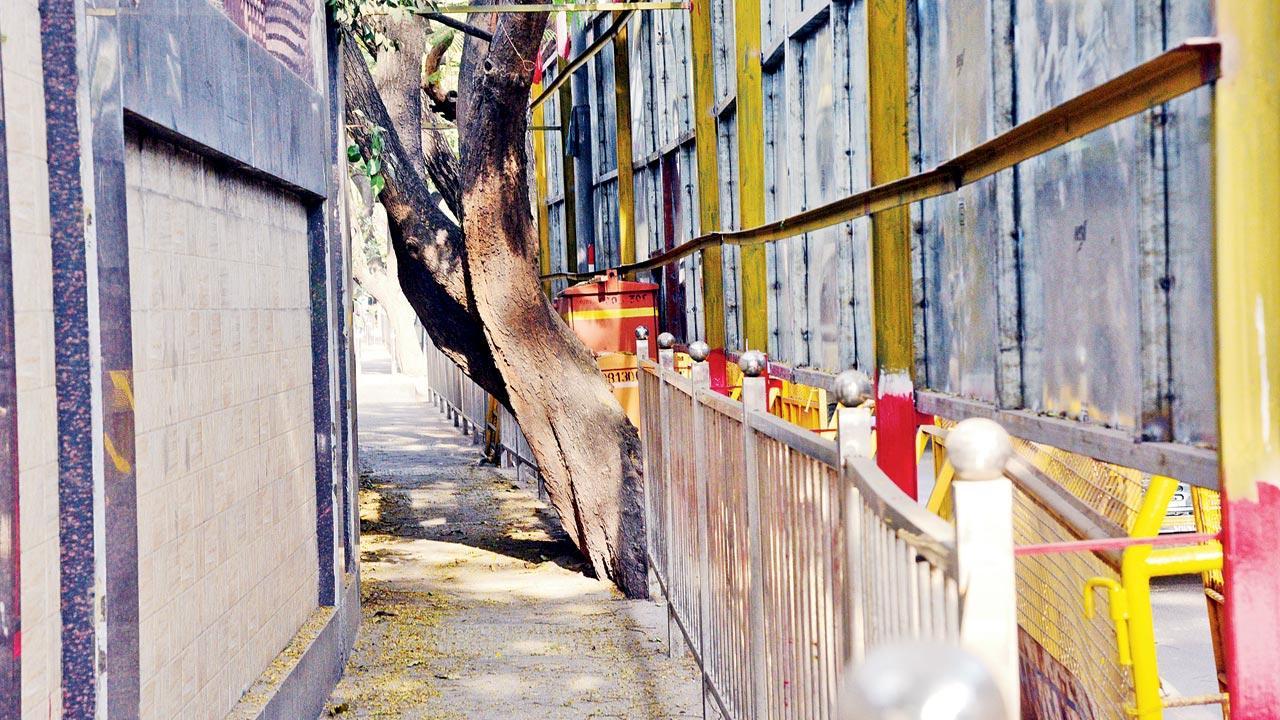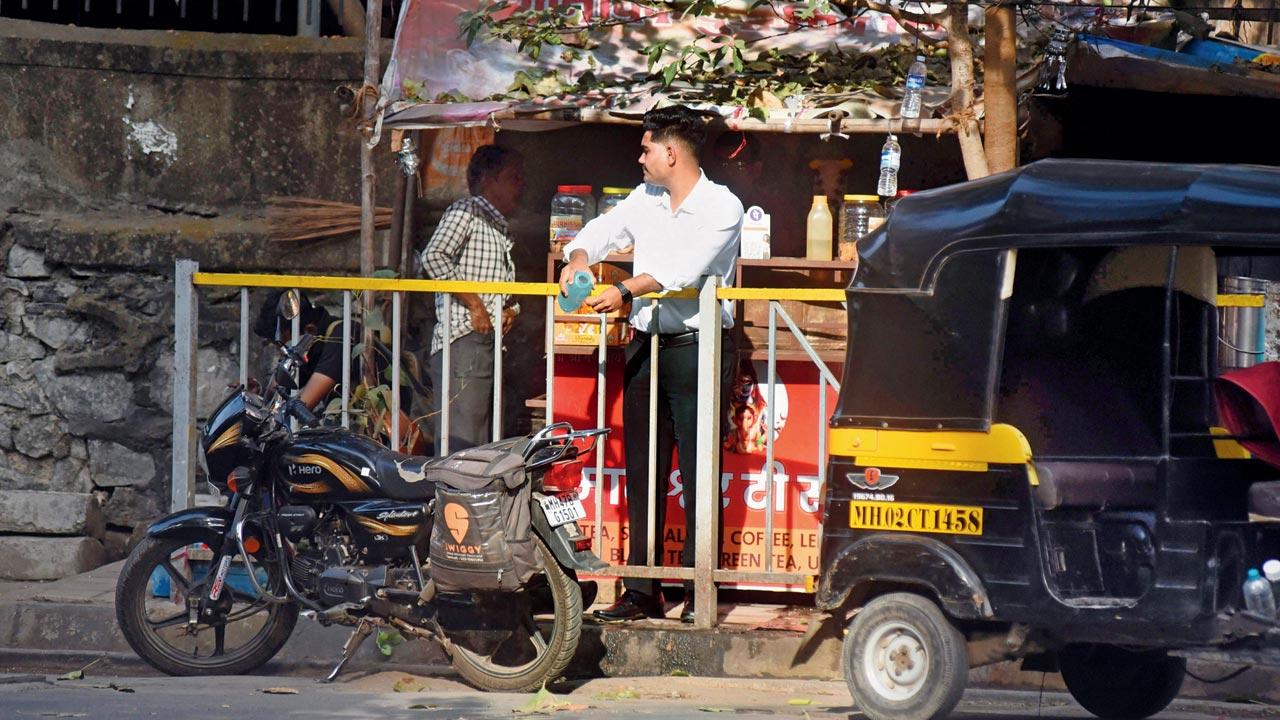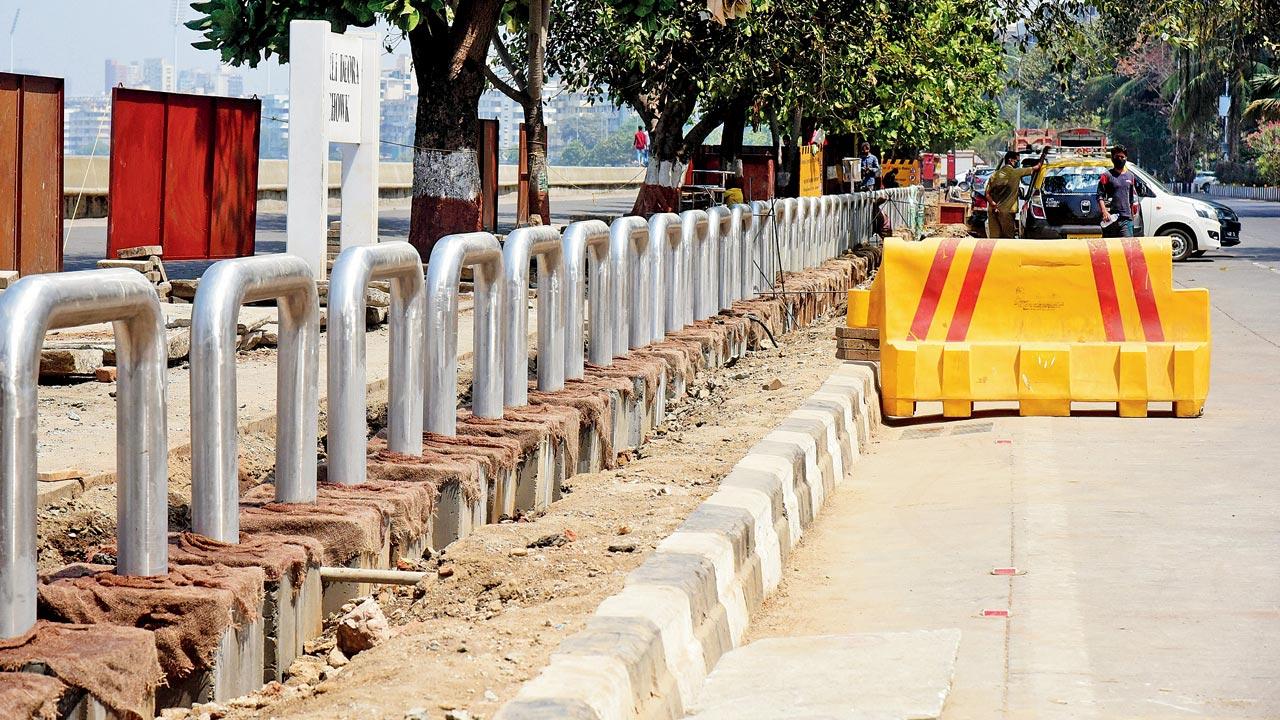In the second of our three-part series, mid-day looks at BMC guidelines on installing barricades for footpaths and where implementation has gone wrong

A narrow footpath near MHADA office at Kalanagar, Bandra. The BMC has set guidelines for the width of the footpath while installing railings, but it is not adhered to. Pic/Pradeep Dhivar
Footpath railings and guardrails are meant to make the pavement accessible to pedestrians, but the situation on the ground was very different, as mid-day reported in the first part of the series on footpath railings on January 16. After assessing the situation, mid-day finds out what rules are in place regarding installation of guardrails and bollards and if they are followed. While the BMC has two sets of guidelines regarding this, corporators said the problem was the lack of practical planning while installing the railings and the subsequent hawker menace that keeps pedestrians away from footpaths.
The Brihanmumbai Municipal Corporation first published a manual for ‘the planning and design guidelines for street furniture for Mumbai and its suburbs’ in 2001. The manual has detailed descriptions about installation of street furniture, which includes barriers such as guardrails, railings and bollards among other things. Citing that footpath barriers are meant to ensure pedestrian safety from vehicular movement on the road, the manual stated that these should be installed at places with heavy traffic or risk, such as junctions, bends, brows of hills.
 A tea stall vendor extended his shop on the footpath by taking advantage of the railings, near Shimpoli, Kandivli. Pic/Sameer Markande
A tea stall vendor extended his shop on the footpath by taking advantage of the railings, near Shimpoli, Kandivli. Pic/Sameer Markande
It also mentioned specific designs and materials for street furniture. It mandates that the length of each panel of railing should be 2 metres and the height should be 1.1 m while the material should be galvanised or stainless steel. The manual also mentioned a specific colour scheme for uniformity.
Also Read: Mumbai: It’s residents vs hawkers in Bandra once again!
‘Pedestrian first’
Later in 2014, the municipal corporation came out with ‘Pedestrian First Footpath Guidelines’. This reinstated that railings should be considered at congested roads and locations where vehicles move at a fast pace as well as junctions, intersections, near schools, colleges, bus stops, railway stations, overpasses, subways, etc. It also took into account existing utilities and trees and made provisions to keep a gap between railings to make space for these.
 Steel pipe barriers installed along Marine Drive. File pic
Steel pipe barriers installed along Marine Drive. File pic
The policy, aimed at giving Mumbaikars space to walk, also mentions, “Sometimes the extent of encroachment rises to a level that the footpath facility becomes inaccessible/non-usable by the pedestrian. To assure increased comfort, uninterrupted access, optimum footpath width, encroachment of all forms of footpath shall be removed.”
The problem
One of the issues mid-day noticed in these guidelines is that neither of them mention which department is supposed to implement that plan. When asked, the assistant municipal commissioner of a ward in the western suburbs said, “The railings are installed by the BMC’s roads department.”
 People use a footpath railing as a place to sit near Ghatkopar. File pic
People use a footpath railing as a place to sit near Ghatkopar. File pic
An engineer from the roads department told mid-day that the railings are brought and installed as per the instruction from the traffic police. Another engineer explained the process and said, “The civic road department appoints an agency to provide railings, as per the requirement, for the entire city. Railings on big roads, highways and junctions are installed by the roads department and the traffic department issues the design which mentions where to keep gaps between railings and bollards.”
The official added, “Corporators, MLAs and MPs can also recommend installing these street furniture on internal roads, etc to BMC ward offices.”
When asked about finalisation of the design, another engineer told mid-day, “The gaps between railings are given keeping in mind the main aim, which is preventing pedestrians from breaking the chain of vehicular movement. The decision regarding this is taken at the executive or deputy engineer level.”
A BMC official told mid-day, “Sometimes footpaths are given to big hotels, companies to take care of and these companies sometimes use glass fibre railings to enhance the look. However, the BMC uses only standardised railings as per the designs mentioned in the manual. Earlier the railings were made of mild steel. But these were getting stolen as they have resale value. So, now we use FRP (fibre reinforced plastic) which has the same strength as mild steel but does not have any resale value.”
Good idea gone bad
Prabhakar Shinde, former corporator from Mulund, said, “A few years ago, the proposal to buy and install railings for footpaths was tabled in the BMC standing committee to keep hawkers away from roads. However, after a lot of money was spent to install the same, it is hawkers who seem to have benefitted. They have uprooted railings at some spots, or used the railings to take over the entire footpath, thus posing more inconvenience to pedestrians. The BMC must review the situation as the purpose behind installing the railings is not being fulfilled. The authorities should also inquire into the uprooting of railings and find out who are behind it.”
“Footpath guardrails are a good idea for the safety and ease of pedestrians as well as vehicular movement. We, corporators, too make demands for installing it to the BMC, and sometimes even pay for the same from our fund. But I think there is need for proper planning before implementing this,” said former corporator Abhijeet Samant from Andheri.
A corporator from the eastern suburbs told mid-day, “It is one of the classic examples of how a good idea is turned into an obstacle. Railings are recommended on footpaths all over the world for pedestrian safety, to restrict entry of two-wheelers and keep the path free of hawkers, but the railings in Mumbai do not fulfil any of these purposes. On the contrary, these have become safety nets for hawkers who encroach upon the footpath.”
“The BMC should apply its mind while implementing guidelines. The quality of railings is not up to the mark and it tends to bend after a few months. The policy mentions the width of the footpath, but at many locations footpaths have become so narrow after installation of railings that there is no space to walk. Even the design and colour of railings are different at different locations,” said Ravi Raja, Congress leader.
2014
Year when the BMC issued Pedestrian First policy
 Subscribe today by clicking the link and stay updated with the latest news!" Click here!
Subscribe today by clicking the link and stay updated with the latest news!" Click here!










